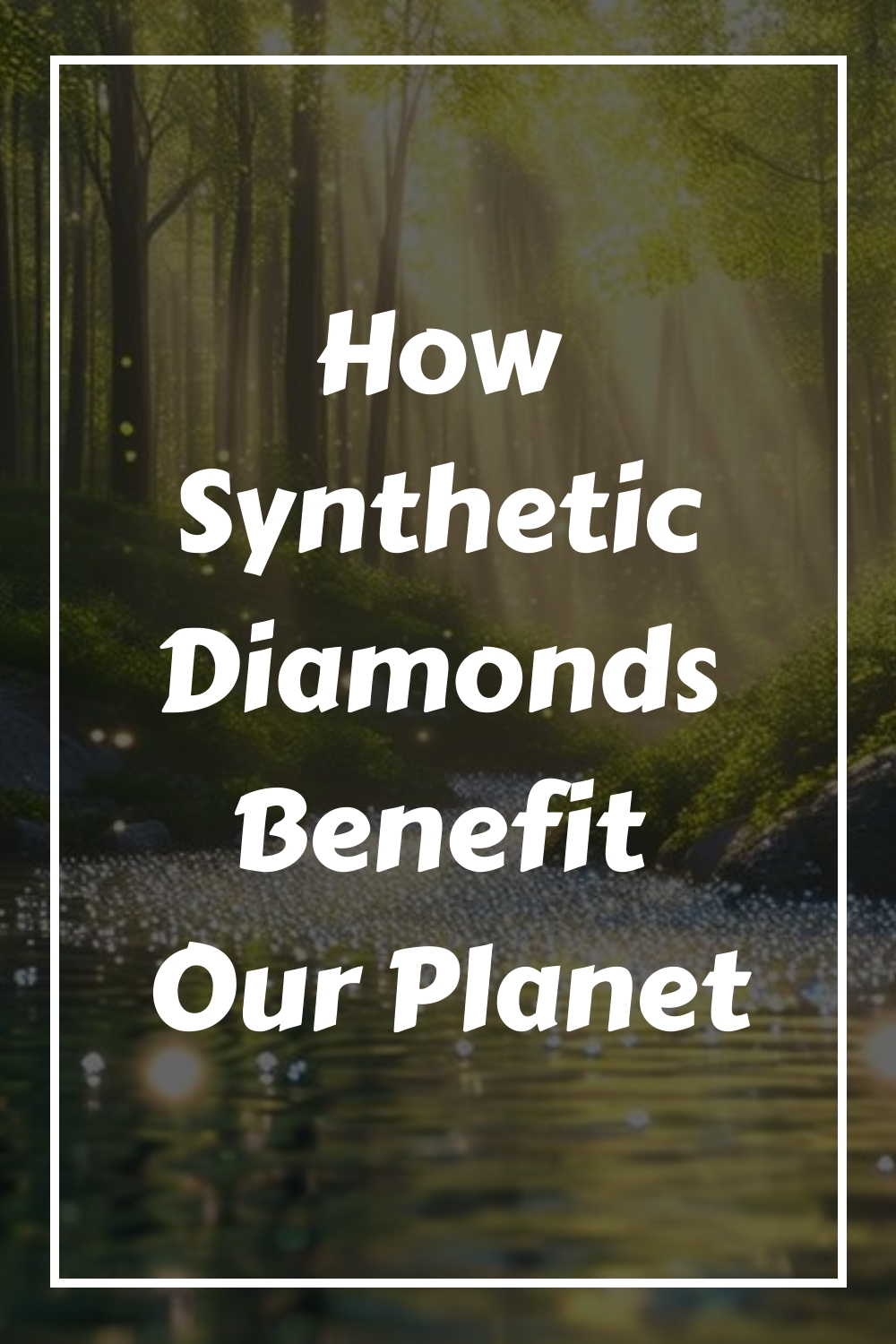Article Contents
Synthetic diamonds exemplify a blend of luxury and environmental responsibility. These lab-grown gems significantly reduce environmental impact compared to traditional diamond mining. They produce lower carbon emissions, utilise up to 250 gallons less water per carat, and consume nearly half the energy.
Synthetic diamonds mitigate the extensive land and water degradation associated with conventional mining, thereby helping to preserve natural landscapes and reduce their ecological footprint. Furthermore, their production supports biodiversity and promotes long-term sustainability.
As symbols of both affluence and conscientiousness, synthetic diamonds offer a sustainable choice for eco-aware consumers. Adopting synthetic diamonds can deepen one's appreciation of their positive environmental effects.
Key Points
- Synthetic diamonds produce significantly lower carbon emissions than their mined counterparts.
- The production of lab-grown diamonds requires substantially less water, thus conserving essential resources.
- Choosing synthetic diamonds reduces ecological disruption and aids in preserving natural biodiversity.
- The production process for artificial diamonds is usually more energy-efficient and often uses renewable energy sources.
- The use of synthetic diamonds promotes long-term environmental sustainability by reducing waste and optimising resource management.
Reduced Carbon Emissions
Lab-grown diamonds produce significantly fewer carbon emissions than mined diamonds, offering a sustainable alternative in the luxury market. This method of diamond production, while still requiring energy, utilises advanced technologies to minimise environmental impact and greenhouse gas emissions. In comparison, mined diamonds result in approximately 140 lbs of CO2 emissions per carat, highlighting the environmental benefits of choosing synthetic diamonds.
Opting for lab-grown diamonds reflects a commitment to both luxury and environmental responsibility. These diamonds serve as symbols of love and commitment, while also supporting ecological sustainability. This choice allows consumers to enjoy luxury responsibly, aligning with values of environmental preservation.
Reduce water usage
Synthetic diamonds significantly reduce water usage compared to mined diamonds. By using advanced technologies, lab-grown diamonds minimise environmental impact by conserving water, aligning with sustainable practices in the jewellery industry.
This approach not only helps with global water conservation but also offers an ethically sound option for environmentally conscious consumers.
Reduced Extraction Impact
Synthetic diamonds offer a significant environmental benefit by using considerably less water than traditional mining methods. Each carat of lab-grown diamonds utilises up to 250 gallons less water, thus dramatically reducing the impact on local water resources and ecosystems.
In contrast, traditional diamond mining consumes approximately 126 gallons of water per carat, leading to environmental degradation and exacerbating water scarcity in mining areas. Choosing synthetic diamonds supports environmental conservation and resource preservation, aligning with eco-friendly values and positioning synthetic diamonds as a sustainable luxury choice.
Improved Sustainability Practices
Enhanced sustainability practices in the production of synthetic diamonds significantly reduce environmental impacts by focusing on water conservation. These practices align with resource conservation principles and demonstrate a commitment to environmental stewardship. By using advanced technologies, synthetic diamond producers effectively reduce water wastage, thus improving the sustainability of their operations. The following table illustrates the benefits of these practices by comparing water usage and environmental impact between synthetic and mined diamonds:
| Aspect | Synthetic Diamonds | Mined Diamonds |
|---|---|---|
| Water Usage per Carat | Up to 50% less | Higher |
| Environmental Impact | Lower | Higher |
| Sustainability Practices | Enhanced | Traditional |
| Resource Conservation | High | Low |
| Eco-Friendliness | More eco-friendly | Less eco-friendly |
These practices highlight the importance of choosing environmentally friendly alternatives, enabling consumers to opt for diamonds that are both visually appealing and environmentally responsible.
Minimal Ecological Disruption
The production of artificial diamonds significantly reduces land degradation compared to conventional diamond mining, which often causes long-term environmental damage.
By avoiding the harmful waste associated with traditional mining, these lab-grown diamonds also minimise water pollution, thereby helping to preserve water quality.
This move towards artificial diamonds not only promotes sustainable practices within the jewellery industry but also helps maintain the balance of ecosystems, representing a crucial step forward in environmental conservation.
Reduced Land Degradation
Lab-grown diamonds significantly reduce land degradation compared to traditional diamond mining. By avoiding extensive mining operations such as open-pit or underground excavations, the production of synthetic diamonds preserves natural landscapes and ecosystems. This method supports the conservation of habitats and species reliant on these undisturbed areas.
Switching to lab-created diamonds reduces the environmental impact, aligning with sustainable practices that protect our planet's ecological balance. Therefore, these diamonds not only offer aesthetic appeal but also represent an environmentally responsible choice, providing consumers with both beauty and a clear conscience.
Reduced Water Pollution
Synthetic diamond production offers significant environmental advantages, especially in terms of reducing water pollution. Unlike traditional mining, which involves substantial water consumption and frequently results in ecosystem contamination, the creation of lab-grown diamonds uses much less water. This not only aids in preserving essential water resources but also reduces water pollution, thus bolstering healthier ecosystems.
Consumers who select synthetic diamonds contribute to water conservation and adopt a sustainable approach that lessens the environmental impact and advocates for a cleaner environment. Choosing lab-grown diamonds is a conscious choice that promotes sustainability and decreases environmental harm.
Energy Efficiency Advantages
Artificial diamonds offer considerable energy efficiency advantages, using up to 50% less energy during production compared to natural diamonds. This decrease in energy consumption results in a smaller ecological footprint, in line with the growing demand for sustainable manufacturing practices. The incorporation of renewable energy sources such as solar, wind, or hydroelectric power in the production of artificial diamonds enhances these benefits, contributing to more environmentally friendly production methods.
- Reduced Carbon Footprint: Decreased energy requirements for producing artificial diamonds result in lower greenhouse gas emissions.
- Integration of Renewable Energy: The production process benefits from the use of renewable energy, promoting sustainability.
- Optimised Manufacturing: Cutting-edge technologies in manufacturing processes reduce energy wastage.
- Sustainable Practice Alignment: This supports global initiatives aimed at reducing industrial energy consumption.
- Minimisation of Environmental Impact: Efficient energy usage leads to reduced environmental damage.
The energy efficiency of artificial diamonds enables consumers to select a product that aligns with their environmental values while still maintaining high quality and aesthetic appeal. Artificial diamonds therefore represent not only a symbol of love and commitment but also a dedication to the sustainable and responsible use of our planet's resources.
Ethical Production Practices

The production of artificial diamonds offers significant environmental benefits and upholds ethical standards that address crucial social issues. This industry introduces a new level of transparency, enabling the traceability of each stone's origins and ensuring that it is free from human rights abuses or exploitative labour practices often associated with traditional diamond mining.
Lab-created diamonds represent a shift towards responsible sourcing, as manufacturers can confidently assert that their products are conflict-free, avoiding the historical issues of blood diamonds and exploitation in diamond-rich areas. This claim is supported by verifiable evidence, appealing to consumers who are increasingly aware of their ethical and global impact.
Opting for synthetic diamonds promotes ethically responsible practices within the jewellery industry, aligning consumer purchases with their values. This movement not only supports a more equitable economy but also advances the cause of freedom and justice worldwide.
Reduced Land Degradation
Synthetic diamonds significantly reduce land degradation compared to traditional diamond mining. By moving away from extensive land excavation to controlled laboratory environments, this method greatly lessens the environmental impact of diamond production. This approach not only decreases the physical footprint but also protects natural landscapes and the wildlife that rely on them.
- Reduced Ecosystem Disruption: Laboratory production of diamonds prevents the extensive soil and habitat disruption linked to open-pit mining, helping to maintain ecological balance.
- Wildlife Preservation: With minimal land disturbance, synthetic diamond production improves the protection of wildlife habitats, supporting wider conservation efforts.
- Conservation of Natural Landscapes: Opting for lab-grown diamonds reduces the intrusion into forests, wetlands, and other crucial habitats.
- Promotion of Biodiversity: Preserving untouched natural areas encourages higher levels of biodiversity, which are essential for ecological health and resilience.
- Support for Ecosystem Restoration: The decrease in landscape damage reduces the necessity for restoration work, enabling conservation resources to be used more efficiently.
Choosing synthetic diamonds is not just a personal or aesthetic decision but a commitment to environmental responsibility. It ensures that our use of precious stones contributes positively to the preservation of the planet's natural beauty and ecological diversity for future generations.
Long-term Sustainability Benefits

Lab-grown diamonds offer significant sustainability benefits by reducing environmental damage and the depletion of natural resources. Their production process causes less disruption to the landscape and generates minimal mineral waste compared to traditional diamond mining. This approach not only promotes environmental conservation but also helps to conserve natural resources for future use.
Furthermore, the creation of lab-grown diamonds requires significantly less energy, leading to lower carbon emissions and contributing to a sustainable future. They also use less water per carat than mined diamonds, contributing to improved water resource management.
By incorporating sustainable practices in the production of lab-grown diamonds, their environmental impact can be further reduced. When consumers choose these synthetic diamonds, they actively support the maintenance of ecological well-being. This decision benefits the environment, ensuring that future generations can appreciate the natural beauty and resources of the planet, while promoting responsible and sustainable luxury.
Frequently Asked Questions
How are synthetic diamonds beneficial for the environment?
Synthetic diamonds are environmentally beneficial as they require less carbon and water than natural diamond mining, thereby reducing ecological impact and supporting sustainable practices in the jewellery industry.
What are the benefits of synthetic diamonds?
Artificial diamonds offer an ethical and sustainable alternative in the luxury market. These diamonds, created through advanced technology, reduce environmental impact and ensure ethical sourcing, aligning with contemporary values and providing consumers with responsible choices.
What Are the Benefits of Synthetic Diamonds?
Synthetic diamonds offer a cost-effective and ethical option compared to natural diamonds. They are more affordable, lowering financial hurdles, and do not carry the substantial environmental and ethical issues linked to traditional diamond mining. This makes them an appealing option for consumers looking for both fashion and sustainability.
How do diamonds impact the environment?
Diamond mining significantly impacts the environment by causing pollution and disrupting ecosystems. The process often results in soil erosion, deforestation, and a decrease in wildlife populations, highlighting the importance of adopting sustainable mining practices.
Conclusion
In conclusion, synthetic diamonds represent a significant advancement in both environmental conservation and ethical practice. These gemstones contribute to ecological sustainability by significantly lowering carbon emissions, reducing water consumption, and preventing extensive land damage, addressing the major environmental issues associated with traditional diamond mining.
The example of Gemesis, a leader in the production of high-quality synthetic diamonds, demonstrates how technological innovation can integrate luxury with environmental responsibility, shaping the future of fine jewellery.



